Impact of Artificial Intelligence on HR Policies in Healthcare Organizations
VerifiedAdded on 2023/06/10
|13
|3265
|177
AI Summary
This report discusses the impact of Artificial Intelligence on HR policies in healthcare organizations. It highlights the types of AI that may change the way of work in the health sector and proposes an effective change management strategy. The report also includes Lewisham Hospital as a case study.
Contribute Materials
Your contribution can guide someone’s learning journey. Share your
documents today.
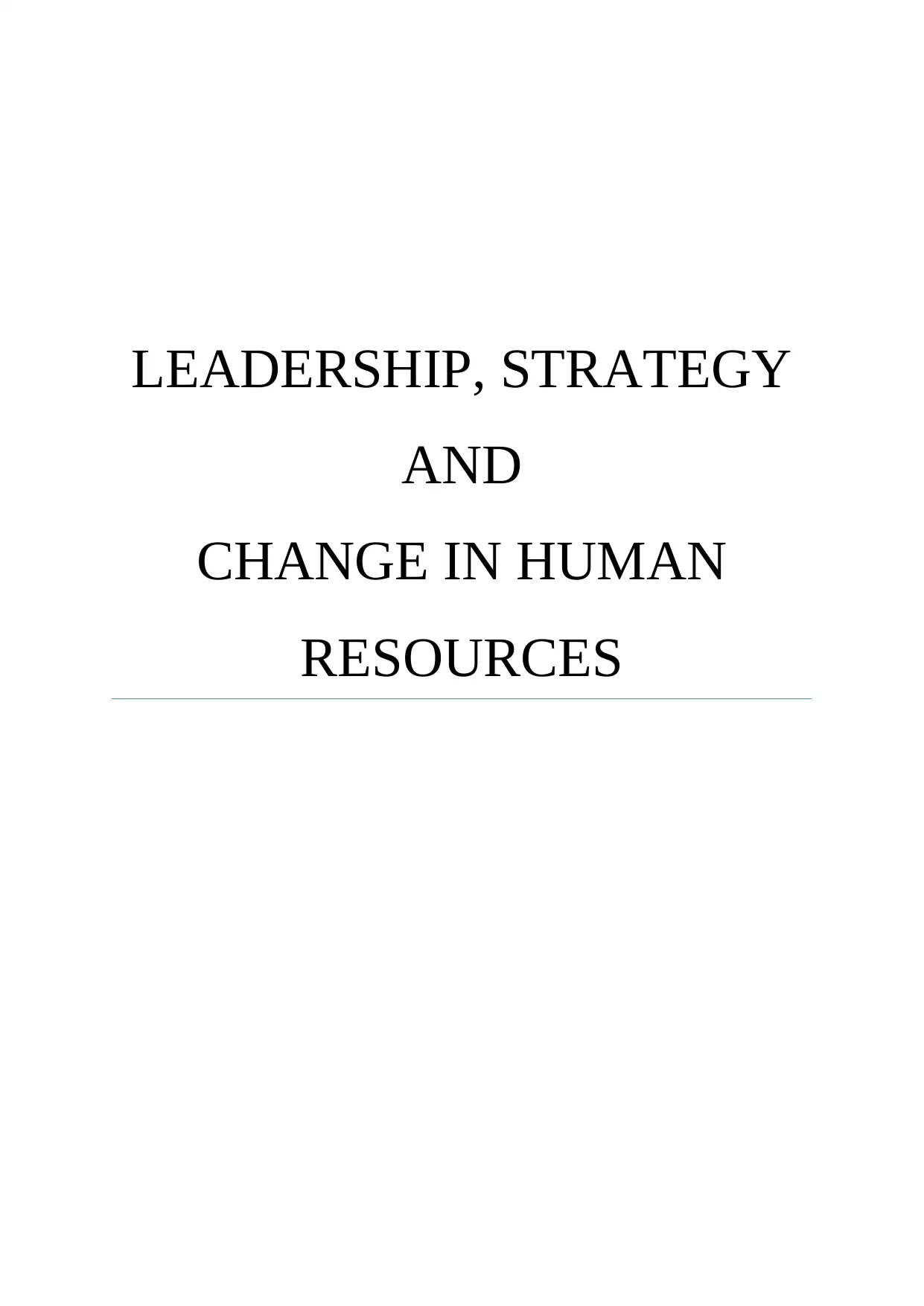
LEADERSHIP, STRATEGY
AND
CHANGE IN HUMAN
RESOURCES
AND
CHANGE IN HUMAN
RESOURCES
Secure Best Marks with AI Grader
Need help grading? Try our AI Grader for instant feedback on your assignments.
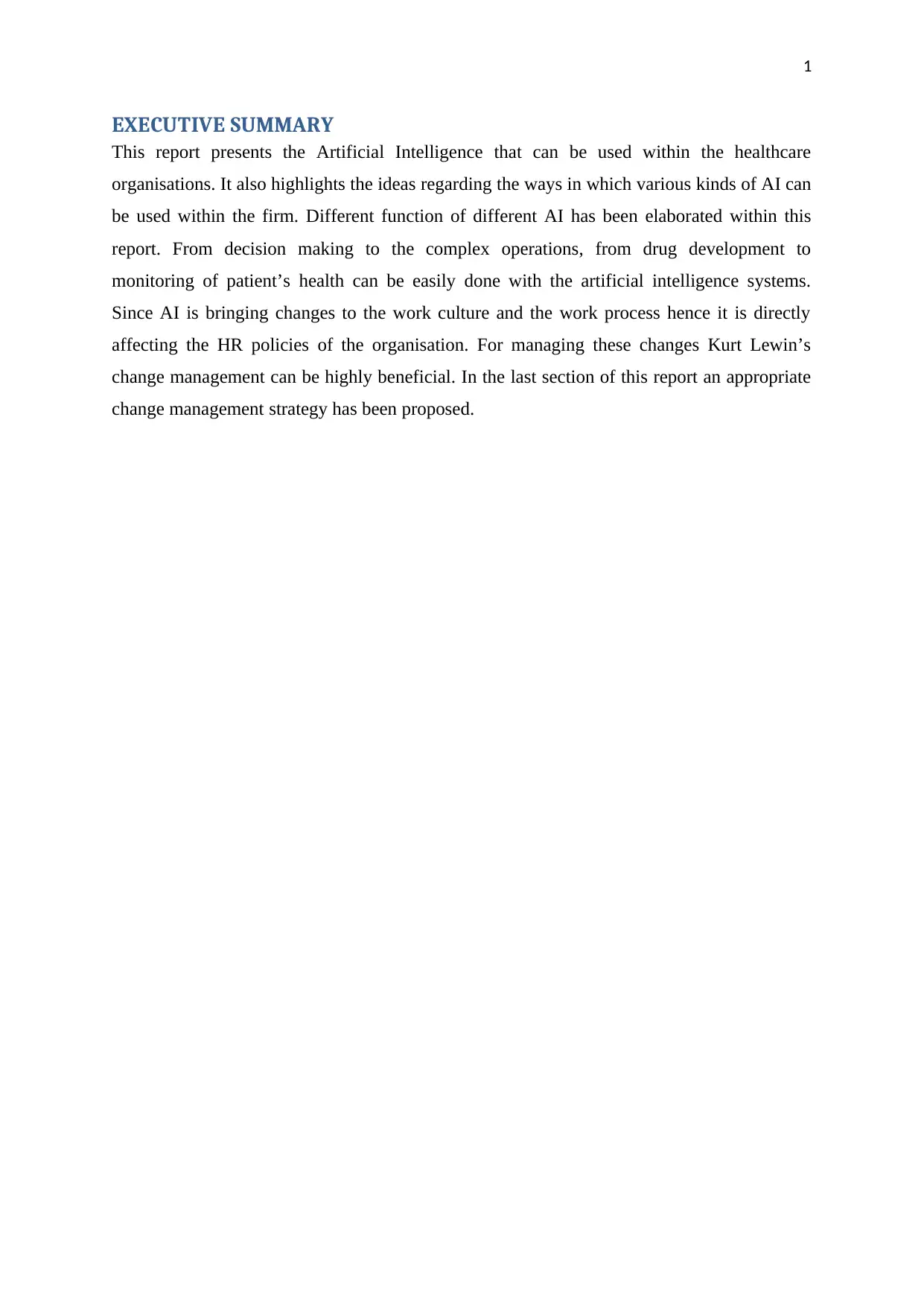
1
EXECUTIVE SUMMARY
This report presents the Artificial Intelligence that can be used within the healthcare
organisations. It also highlights the ideas regarding the ways in which various kinds of AI can
be used within the firm. Different function of different AI has been elaborated within this
report. From decision making to the complex operations, from drug development to
monitoring of patient’s health can be easily done with the artificial intelligence systems.
Since AI is bringing changes to the work culture and the work process hence it is directly
affecting the HR policies of the organisation. For managing these changes Kurt Lewin’s
change management can be highly beneficial. In the last section of this report an appropriate
change management strategy has been proposed.
EXECUTIVE SUMMARY
This report presents the Artificial Intelligence that can be used within the healthcare
organisations. It also highlights the ideas regarding the ways in which various kinds of AI can
be used within the firm. Different function of different AI has been elaborated within this
report. From decision making to the complex operations, from drug development to
monitoring of patient’s health can be easily done with the artificial intelligence systems.
Since AI is bringing changes to the work culture and the work process hence it is directly
affecting the HR policies of the organisation. For managing these changes Kurt Lewin’s
change management can be highly beneficial. In the last section of this report an appropriate
change management strategy has been proposed.
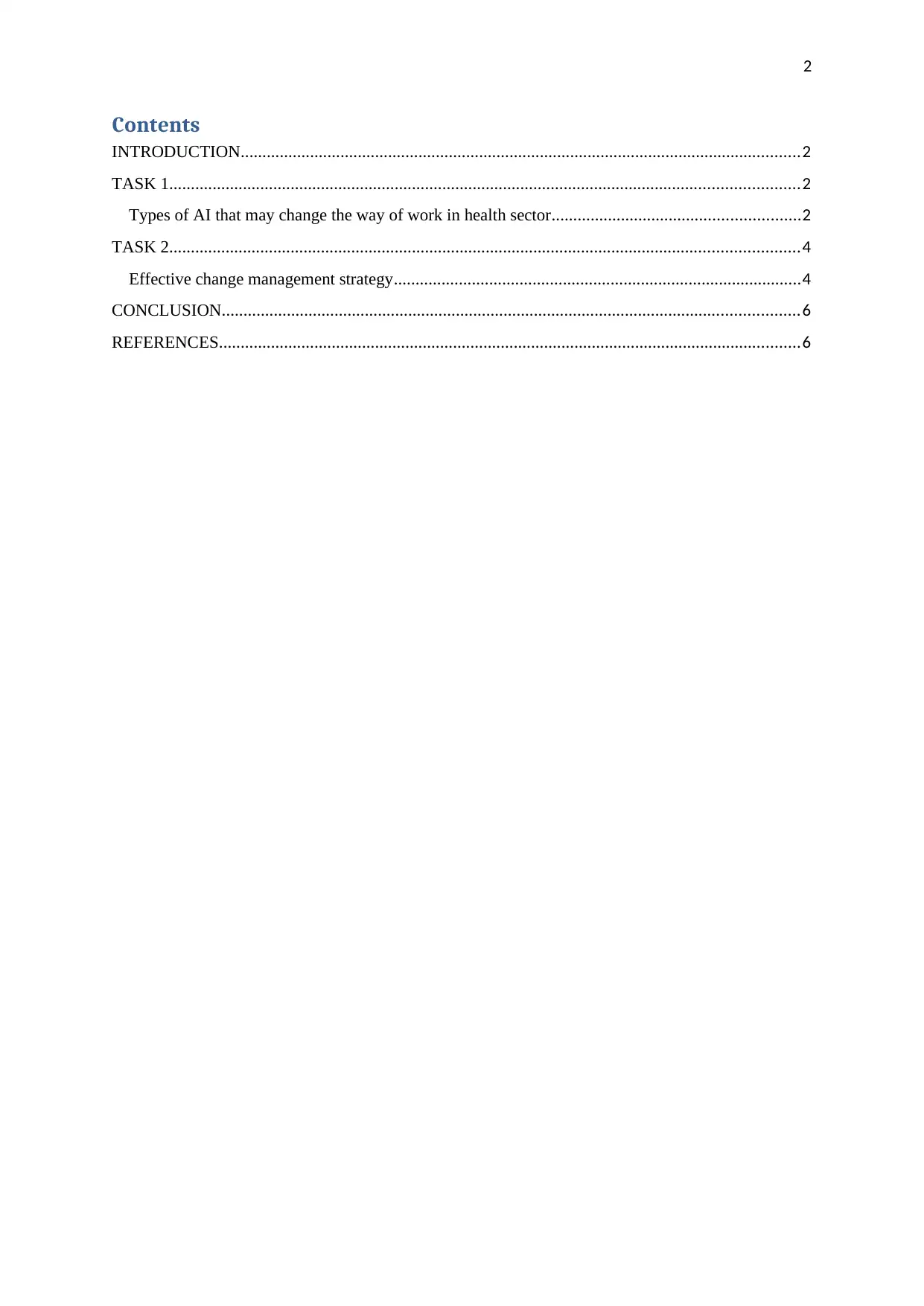
2
Contents
INTRODUCTION.................................................................................................................................2
TASK 1.................................................................................................................................................2
Types of AI that may change the way of work in health sector.........................................................2
TASK 2.................................................................................................................................................4
Effective change management strategy..............................................................................................4
CONCLUSION.....................................................................................................................................6
REFERENCES......................................................................................................................................6
Contents
INTRODUCTION.................................................................................................................................2
TASK 1.................................................................................................................................................2
Types of AI that may change the way of work in health sector.........................................................2
TASK 2.................................................................................................................................................4
Effective change management strategy..............................................................................................4
CONCLUSION.....................................................................................................................................6
REFERENCES......................................................................................................................................6
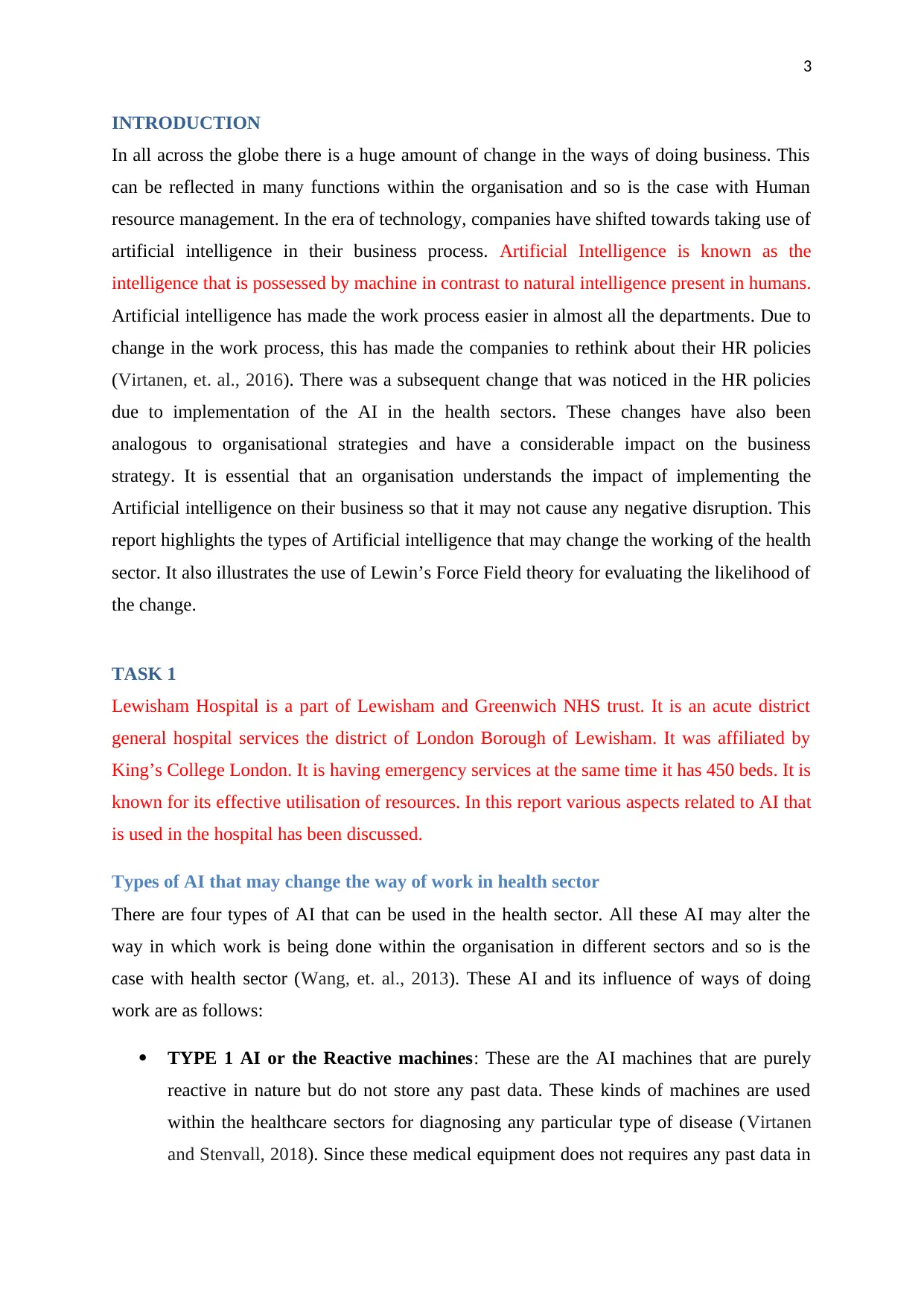
3
INTRODUCTION
In all across the globe there is a huge amount of change in the ways of doing business. This
can be reflected in many functions within the organisation and so is the case with Human
resource management. In the era of technology, companies have shifted towards taking use of
artificial intelligence in their business process. Artificial Intelligence is known as the
intelligence that is possessed by machine in contrast to natural intelligence present in humans.
Artificial intelligence has made the work process easier in almost all the departments. Due to
change in the work process, this has made the companies to rethink about their HR policies
(Virtanen, et. al., 2016). There was a subsequent change that was noticed in the HR policies
due to implementation of the AI in the health sectors. These changes have also been
analogous to organisational strategies and have a considerable impact on the business
strategy. It is essential that an organisation understands the impact of implementing the
Artificial intelligence on their business so that it may not cause any negative disruption. This
report highlights the types of Artificial intelligence that may change the working of the health
sector. It also illustrates the use of Lewin’s Force Field theory for evaluating the likelihood of
the change.
TASK 1
Lewisham Hospital is a part of Lewisham and Greenwich NHS trust. It is an acute district
general hospital services the district of London Borough of Lewisham. It was affiliated by
King’s College London. It is having emergency services at the same time it has 450 beds. It is
known for its effective utilisation of resources. In this report various aspects related to AI that
is used in the hospital has been discussed.
Types of AI that may change the way of work in health sector
There are four types of AI that can be used in the health sector. All these AI may alter the
way in which work is being done within the organisation in different sectors and so is the
case with health sector (Wang, et. al., 2013). These AI and its influence of ways of doing
work are as follows:
TYPE 1 AI or the Reactive machines: These are the AI machines that are purely
reactive in nature but do not store any past data. These kinds of machines are used
within the healthcare sectors for diagnosing any particular type of disease (Virtanen
and Stenvall, 2018). Since these medical equipment does not requires any past data in
INTRODUCTION
In all across the globe there is a huge amount of change in the ways of doing business. This
can be reflected in many functions within the organisation and so is the case with Human
resource management. In the era of technology, companies have shifted towards taking use of
artificial intelligence in their business process. Artificial Intelligence is known as the
intelligence that is possessed by machine in contrast to natural intelligence present in humans.
Artificial intelligence has made the work process easier in almost all the departments. Due to
change in the work process, this has made the companies to rethink about their HR policies
(Virtanen, et. al., 2016). There was a subsequent change that was noticed in the HR policies
due to implementation of the AI in the health sectors. These changes have also been
analogous to organisational strategies and have a considerable impact on the business
strategy. It is essential that an organisation understands the impact of implementing the
Artificial intelligence on their business so that it may not cause any negative disruption. This
report highlights the types of Artificial intelligence that may change the working of the health
sector. It also illustrates the use of Lewin’s Force Field theory for evaluating the likelihood of
the change.
TASK 1
Lewisham Hospital is a part of Lewisham and Greenwich NHS trust. It is an acute district
general hospital services the district of London Borough of Lewisham. It was affiliated by
King’s College London. It is having emergency services at the same time it has 450 beds. It is
known for its effective utilisation of resources. In this report various aspects related to AI that
is used in the hospital has been discussed.
Types of AI that may change the way of work in health sector
There are four types of AI that can be used in the health sector. All these AI may alter the
way in which work is being done within the organisation in different sectors and so is the
case with health sector (Wang, et. al., 2013). These AI and its influence of ways of doing
work are as follows:
TYPE 1 AI or the Reactive machines: These are the AI machines that are purely
reactive in nature but do not store any past data. These kinds of machines are used
within the healthcare sectors for diagnosing any particular type of disease (Virtanen
and Stenvall, 2018). Since these medical equipment does not requires any past data in
Secure Best Marks with AI Grader
Need help grading? Try our AI Grader for instant feedback on your assignments.
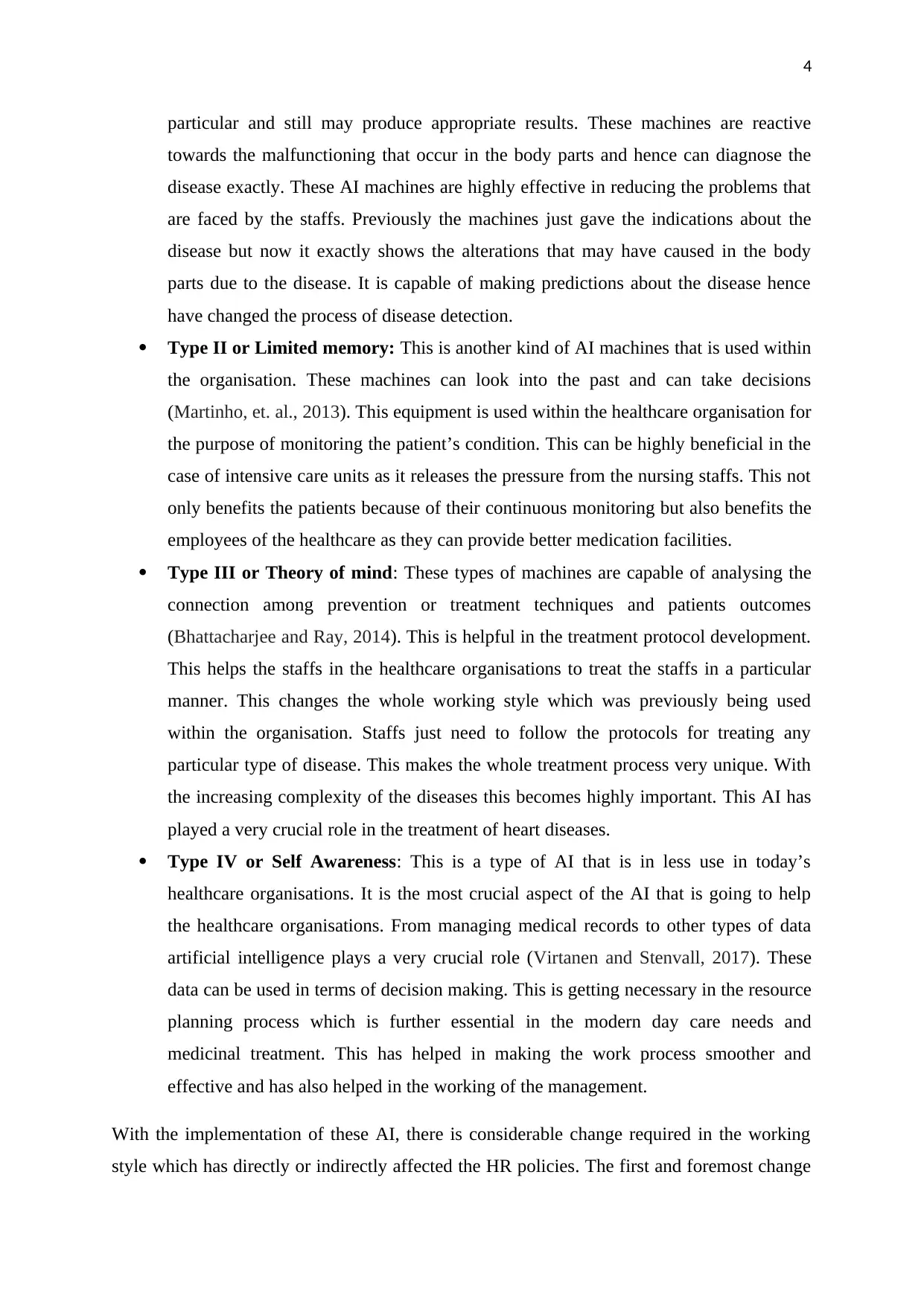
4
particular and still may produce appropriate results. These machines are reactive
towards the malfunctioning that occur in the body parts and hence can diagnose the
disease exactly. These AI machines are highly effective in reducing the problems that
are faced by the staffs. Previously the machines just gave the indications about the
disease but now it exactly shows the alterations that may have caused in the body
parts due to the disease. It is capable of making predictions about the disease hence
have changed the process of disease detection.
Type II or Limited memory: This is another kind of AI machines that is used within
the organisation. These machines can look into the past and can take decisions
(Martinho, et. al., 2013). This equipment is used within the healthcare organisation for
the purpose of monitoring the patient’s condition. This can be highly beneficial in the
case of intensive care units as it releases the pressure from the nursing staffs. This not
only benefits the patients because of their continuous monitoring but also benefits the
employees of the healthcare as they can provide better medication facilities.
Type III or Theory of mind: These types of machines are capable of analysing the
connection among prevention or treatment techniques and patients outcomes
(Bhattacharjee and Ray, 2014). This is helpful in the treatment protocol development.
This helps the staffs in the healthcare organisations to treat the staffs in a particular
manner. This changes the whole working style which was previously being used
within the organisation. Staffs just need to follow the protocols for treating any
particular type of disease. This makes the whole treatment process very unique. With
the increasing complexity of the diseases this becomes highly important. This AI has
played a very crucial role in the treatment of heart diseases.
Type IV or Self Awareness: This is a type of AI that is in less use in today’s
healthcare organisations. It is the most crucial aspect of the AI that is going to help
the healthcare organisations. From managing medical records to other types of data
artificial intelligence plays a very crucial role (Virtanen and Stenvall, 2017). These
data can be used in terms of decision making. This is getting necessary in the resource
planning process which is further essential in the modern day care needs and
medicinal treatment. This has helped in making the work process smoother and
effective and has also helped in the working of the management.
With the implementation of these AI, there is considerable change required in the working
style which has directly or indirectly affected the HR policies. The first and foremost change
particular and still may produce appropriate results. These machines are reactive
towards the malfunctioning that occur in the body parts and hence can diagnose the
disease exactly. These AI machines are highly effective in reducing the problems that
are faced by the staffs. Previously the machines just gave the indications about the
disease but now it exactly shows the alterations that may have caused in the body
parts due to the disease. It is capable of making predictions about the disease hence
have changed the process of disease detection.
Type II or Limited memory: This is another kind of AI machines that is used within
the organisation. These machines can look into the past and can take decisions
(Martinho, et. al., 2013). This equipment is used within the healthcare organisation for
the purpose of monitoring the patient’s condition. This can be highly beneficial in the
case of intensive care units as it releases the pressure from the nursing staffs. This not
only benefits the patients because of their continuous monitoring but also benefits the
employees of the healthcare as they can provide better medication facilities.
Type III or Theory of mind: These types of machines are capable of analysing the
connection among prevention or treatment techniques and patients outcomes
(Bhattacharjee and Ray, 2014). This is helpful in the treatment protocol development.
This helps the staffs in the healthcare organisations to treat the staffs in a particular
manner. This changes the whole working style which was previously being used
within the organisation. Staffs just need to follow the protocols for treating any
particular type of disease. This makes the whole treatment process very unique. With
the increasing complexity of the diseases this becomes highly important. This AI has
played a very crucial role in the treatment of heart diseases.
Type IV or Self Awareness: This is a type of AI that is in less use in today’s
healthcare organisations. It is the most crucial aspect of the AI that is going to help
the healthcare organisations. From managing medical records to other types of data
artificial intelligence plays a very crucial role (Virtanen and Stenvall, 2017). These
data can be used in terms of decision making. This is getting necessary in the resource
planning process which is further essential in the modern day care needs and
medicinal treatment. This has helped in making the work process smoother and
effective and has also helped in the working of the management.
With the implementation of these AI, there is considerable change required in the working
style which has directly or indirectly affected the HR policies. The first and foremost change
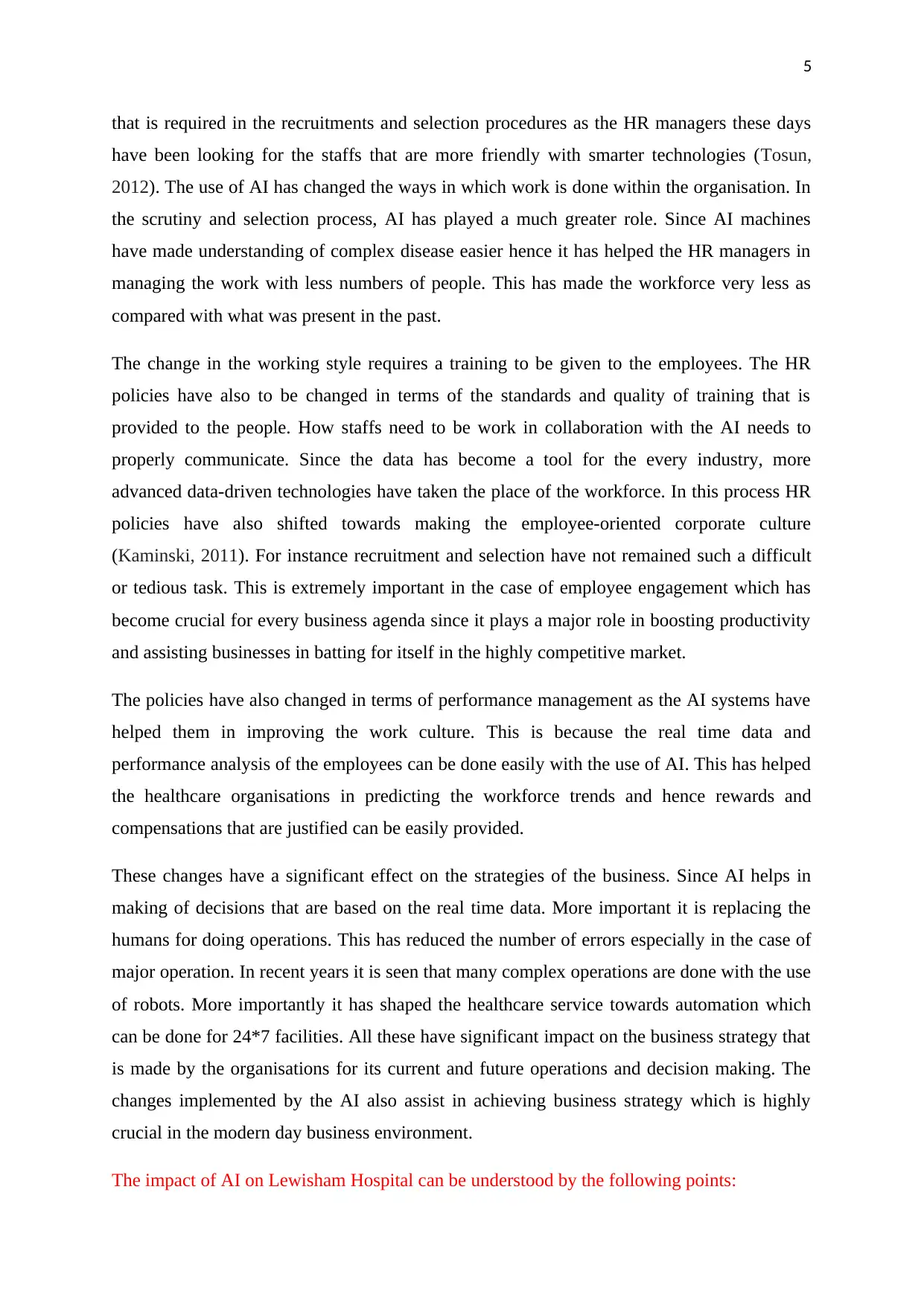
5
that is required in the recruitments and selection procedures as the HR managers these days
have been looking for the staffs that are more friendly with smarter technologies (Tosun,
2012). The use of AI has changed the ways in which work is done within the organisation. In
the scrutiny and selection process, AI has played a much greater role. Since AI machines
have made understanding of complex disease easier hence it has helped the HR managers in
managing the work with less numbers of people. This has made the workforce very less as
compared with what was present in the past.
The change in the working style requires a training to be given to the employees. The HR
policies have also to be changed in terms of the standards and quality of training that is
provided to the people. How staffs need to be work in collaboration with the AI needs to
properly communicate. Since the data has become a tool for the every industry, more
advanced data-driven technologies have taken the place of the workforce. In this process HR
policies have also shifted towards making the employee-oriented corporate culture
(Kaminski, 2011). For instance recruitment and selection have not remained such a difficult
or tedious task. This is extremely important in the case of employee engagement which has
become crucial for every business agenda since it plays a major role in boosting productivity
and assisting businesses in batting for itself in the highly competitive market.
The policies have also changed in terms of performance management as the AI systems have
helped them in improving the work culture. This is because the real time data and
performance analysis of the employees can be done easily with the use of AI. This has helped
the healthcare organisations in predicting the workforce trends and hence rewards and
compensations that are justified can be easily provided.
These changes have a significant effect on the strategies of the business. Since AI helps in
making of decisions that are based on the real time data. More important it is replacing the
humans for doing operations. This has reduced the number of errors especially in the case of
major operation. In recent years it is seen that many complex operations are done with the use
of robots. More importantly it has shaped the healthcare service towards automation which
can be done for 24*7 facilities. All these have significant impact on the business strategy that
is made by the organisations for its current and future operations and decision making. The
changes implemented by the AI also assist in achieving business strategy which is highly
crucial in the modern day business environment.
The impact of AI on Lewisham Hospital can be understood by the following points:
that is required in the recruitments and selection procedures as the HR managers these days
have been looking for the staffs that are more friendly with smarter technologies (Tosun,
2012). The use of AI has changed the ways in which work is done within the organisation. In
the scrutiny and selection process, AI has played a much greater role. Since AI machines
have made understanding of complex disease easier hence it has helped the HR managers in
managing the work with less numbers of people. This has made the workforce very less as
compared with what was present in the past.
The change in the working style requires a training to be given to the employees. The HR
policies have also to be changed in terms of the standards and quality of training that is
provided to the people. How staffs need to be work in collaboration with the AI needs to
properly communicate. Since the data has become a tool for the every industry, more
advanced data-driven technologies have taken the place of the workforce. In this process HR
policies have also shifted towards making the employee-oriented corporate culture
(Kaminski, 2011). For instance recruitment and selection have not remained such a difficult
or tedious task. This is extremely important in the case of employee engagement which has
become crucial for every business agenda since it plays a major role in boosting productivity
and assisting businesses in batting for itself in the highly competitive market.
The policies have also changed in terms of performance management as the AI systems have
helped them in improving the work culture. This is because the real time data and
performance analysis of the employees can be done easily with the use of AI. This has helped
the healthcare organisations in predicting the workforce trends and hence rewards and
compensations that are justified can be easily provided.
These changes have a significant effect on the strategies of the business. Since AI helps in
making of decisions that are based on the real time data. More important it is replacing the
humans for doing operations. This has reduced the number of errors especially in the case of
major operation. In recent years it is seen that many complex operations are done with the use
of robots. More importantly it has shaped the healthcare service towards automation which
can be done for 24*7 facilities. All these have significant impact on the business strategy that
is made by the organisations for its current and future operations and decision making. The
changes implemented by the AI also assist in achieving business strategy which is highly
crucial in the modern day business environment.
The impact of AI on Lewisham Hospital can be understood by the following points:
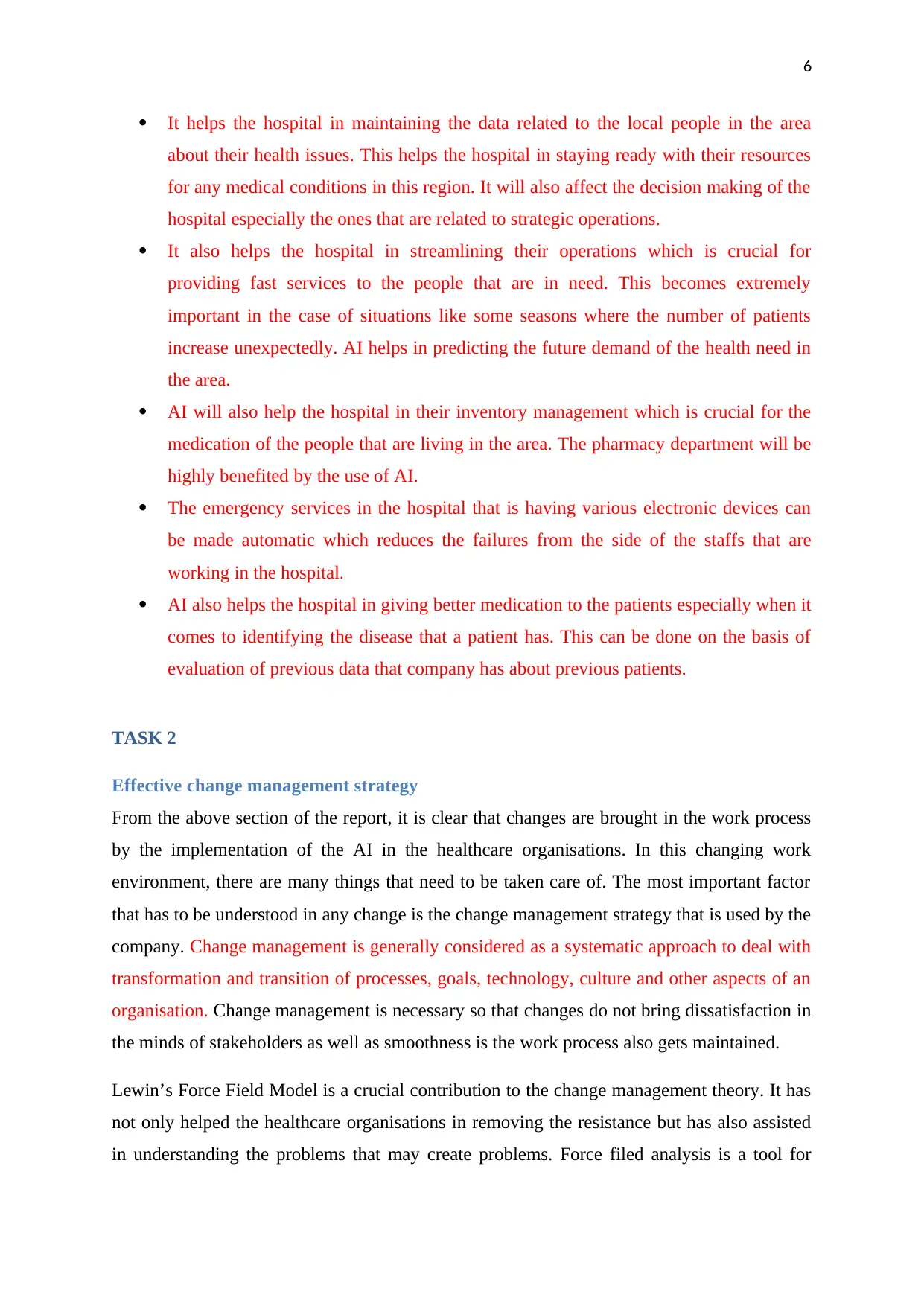
6
It helps the hospital in maintaining the data related to the local people in the area
about their health issues. This helps the hospital in staying ready with their resources
for any medical conditions in this region. It will also affect the decision making of the
hospital especially the ones that are related to strategic operations.
It also helps the hospital in streamlining their operations which is crucial for
providing fast services to the people that are in need. This becomes extremely
important in the case of situations like some seasons where the number of patients
increase unexpectedly. AI helps in predicting the future demand of the health need in
the area.
AI will also help the hospital in their inventory management which is crucial for the
medication of the people that are living in the area. The pharmacy department will be
highly benefited by the use of AI.
The emergency services in the hospital that is having various electronic devices can
be made automatic which reduces the failures from the side of the staffs that are
working in the hospital.
AI also helps the hospital in giving better medication to the patients especially when it
comes to identifying the disease that a patient has. This can be done on the basis of
evaluation of previous data that company has about previous patients.
TASK 2
Effective change management strategy
From the above section of the report, it is clear that changes are brought in the work process
by the implementation of the AI in the healthcare organisations. In this changing work
environment, there are many things that need to be taken care of. The most important factor
that has to be understood in any change is the change management strategy that is used by the
company. Change management is generally considered as a systematic approach to deal with
transformation and transition of processes, goals, technology, culture and other aspects of an
organisation. Change management is necessary so that changes do not bring dissatisfaction in
the minds of stakeholders as well as smoothness is the work process also gets maintained.
Lewin’s Force Field Model is a crucial contribution to the change management theory. It has
not only helped the healthcare organisations in removing the resistance but has also assisted
in understanding the problems that may create problems. Force filed analysis is a tool for
It helps the hospital in maintaining the data related to the local people in the area
about their health issues. This helps the hospital in staying ready with their resources
for any medical conditions in this region. It will also affect the decision making of the
hospital especially the ones that are related to strategic operations.
It also helps the hospital in streamlining their operations which is crucial for
providing fast services to the people that are in need. This becomes extremely
important in the case of situations like some seasons where the number of patients
increase unexpectedly. AI helps in predicting the future demand of the health need in
the area.
AI will also help the hospital in their inventory management which is crucial for the
medication of the people that are living in the area. The pharmacy department will be
highly benefited by the use of AI.
The emergency services in the hospital that is having various electronic devices can
be made automatic which reduces the failures from the side of the staffs that are
working in the hospital.
AI also helps the hospital in giving better medication to the patients especially when it
comes to identifying the disease that a patient has. This can be done on the basis of
evaluation of previous data that company has about previous patients.
TASK 2
Effective change management strategy
From the above section of the report, it is clear that changes are brought in the work process
by the implementation of the AI in the healthcare organisations. In this changing work
environment, there are many things that need to be taken care of. The most important factor
that has to be understood in any change is the change management strategy that is used by the
company. Change management is generally considered as a systematic approach to deal with
transformation and transition of processes, goals, technology, culture and other aspects of an
organisation. Change management is necessary so that changes do not bring dissatisfaction in
the minds of stakeholders as well as smoothness is the work process also gets maintained.
Lewin’s Force Field Model is a crucial contribution to the change management theory. It has
not only helped the healthcare organisations in removing the resistance but has also assisted
in understanding the problems that may create problems. Force filed analysis is a tool for
Paraphrase This Document
Need a fresh take? Get an instant paraphrase of this document with our AI Paraphraser
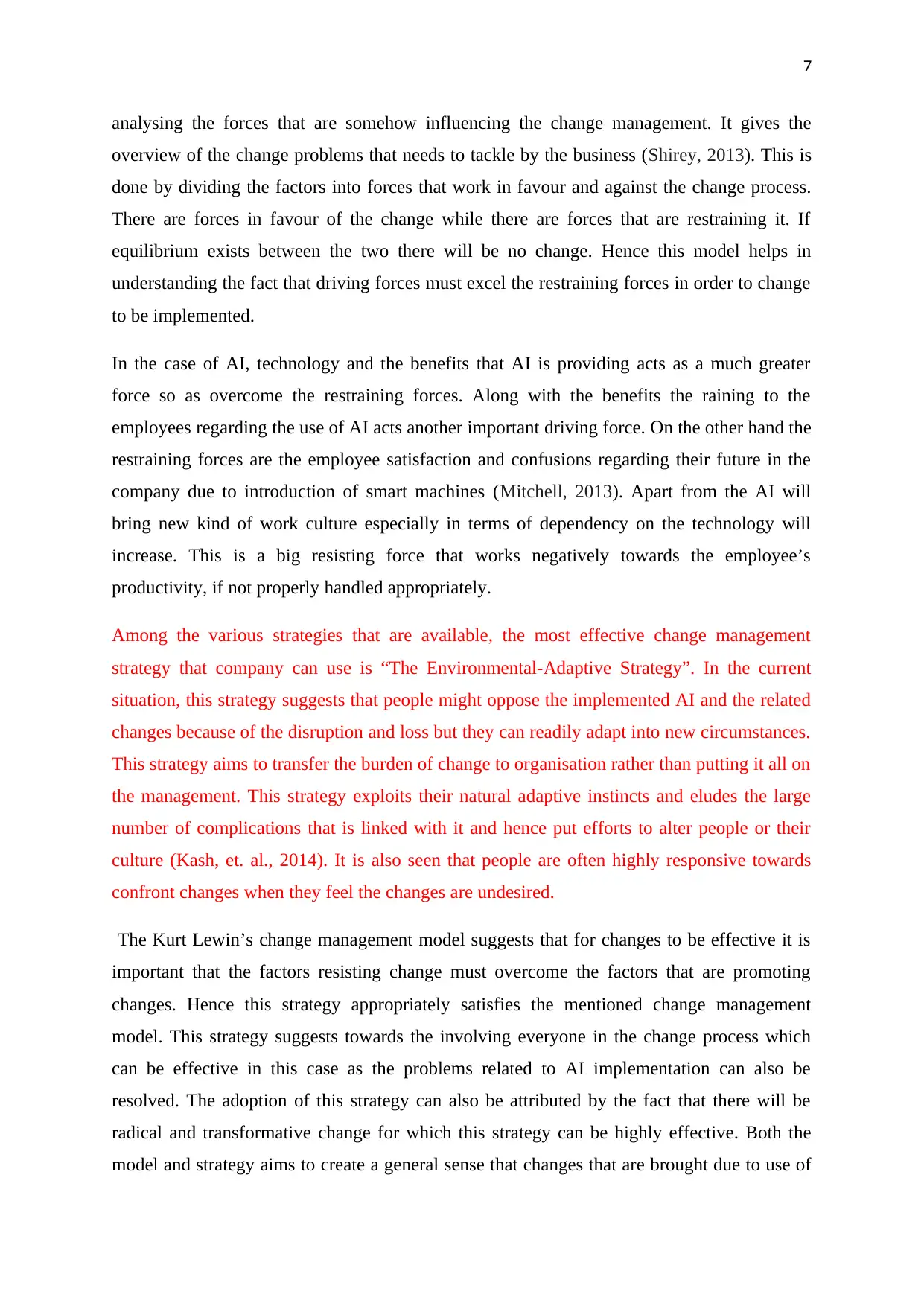
7
analysing the forces that are somehow influencing the change management. It gives the
overview of the change problems that needs to tackle by the business (Shirey, 2013). This is
done by dividing the factors into forces that work in favour and against the change process.
There are forces in favour of the change while there are forces that are restraining it. If
equilibrium exists between the two there will be no change. Hence this model helps in
understanding the fact that driving forces must excel the restraining forces in order to change
to be implemented.
In the case of AI, technology and the benefits that AI is providing acts as a much greater
force so as overcome the restraining forces. Along with the benefits the raining to the
employees regarding the use of AI acts another important driving force. On the other hand the
restraining forces are the employee satisfaction and confusions regarding their future in the
company due to introduction of smart machines (Mitchell, 2013). Apart from the AI will
bring new kind of work culture especially in terms of dependency on the technology will
increase. This is a big resisting force that works negatively towards the employee’s
productivity, if not properly handled appropriately.
Among the various strategies that are available, the most effective change management
strategy that company can use is “The Environmental-Adaptive Strategy”. In the current
situation, this strategy suggests that people might oppose the implemented AI and the related
changes because of the disruption and loss but they can readily adapt into new circumstances.
This strategy aims to transfer the burden of change to organisation rather than putting it all on
the management. This strategy exploits their natural adaptive instincts and eludes the large
number of complications that is linked with it and hence put efforts to alter people or their
culture (Kash, et. al., 2014). It is also seen that people are often highly responsive towards
confront changes when they feel the changes are undesired.
The Kurt Lewin’s change management model suggests that for changes to be effective it is
important that the factors resisting change must overcome the factors that are promoting
changes. Hence this strategy appropriately satisfies the mentioned change management
model. This strategy suggests towards the involving everyone in the change process which
can be effective in this case as the problems related to AI implementation can also be
resolved. The adoption of this strategy can also be attributed by the fact that there will be
radical and transformative change for which this strategy can be highly effective. Both the
model and strategy aims to create a general sense that changes that are brought due to use of
analysing the forces that are somehow influencing the change management. It gives the
overview of the change problems that needs to tackle by the business (Shirey, 2013). This is
done by dividing the factors into forces that work in favour and against the change process.
There are forces in favour of the change while there are forces that are restraining it. If
equilibrium exists between the two there will be no change. Hence this model helps in
understanding the fact that driving forces must excel the restraining forces in order to change
to be implemented.
In the case of AI, technology and the benefits that AI is providing acts as a much greater
force so as overcome the restraining forces. Along with the benefits the raining to the
employees regarding the use of AI acts another important driving force. On the other hand the
restraining forces are the employee satisfaction and confusions regarding their future in the
company due to introduction of smart machines (Mitchell, 2013). Apart from the AI will
bring new kind of work culture especially in terms of dependency on the technology will
increase. This is a big resisting force that works negatively towards the employee’s
productivity, if not properly handled appropriately.
Among the various strategies that are available, the most effective change management
strategy that company can use is “The Environmental-Adaptive Strategy”. In the current
situation, this strategy suggests that people might oppose the implemented AI and the related
changes because of the disruption and loss but they can readily adapt into new circumstances.
This strategy aims to transfer the burden of change to organisation rather than putting it all on
the management. This strategy exploits their natural adaptive instincts and eludes the large
number of complications that is linked with it and hence put efforts to alter people or their
culture (Kash, et. al., 2014). It is also seen that people are often highly responsive towards
confront changes when they feel the changes are undesired.
The Kurt Lewin’s change management model suggests that for changes to be effective it is
important that the factors resisting change must overcome the factors that are promoting
changes. Hence this strategy appropriately satisfies the mentioned change management
model. This strategy suggests towards the involving everyone in the change process which
can be effective in this case as the problems related to AI implementation can also be
resolved. The adoption of this strategy can also be attributed by the fact that there will be
radical and transformative change for which this strategy can be highly effective. Both the
model and strategy aims to create a general sense that changes that are brought due to use of
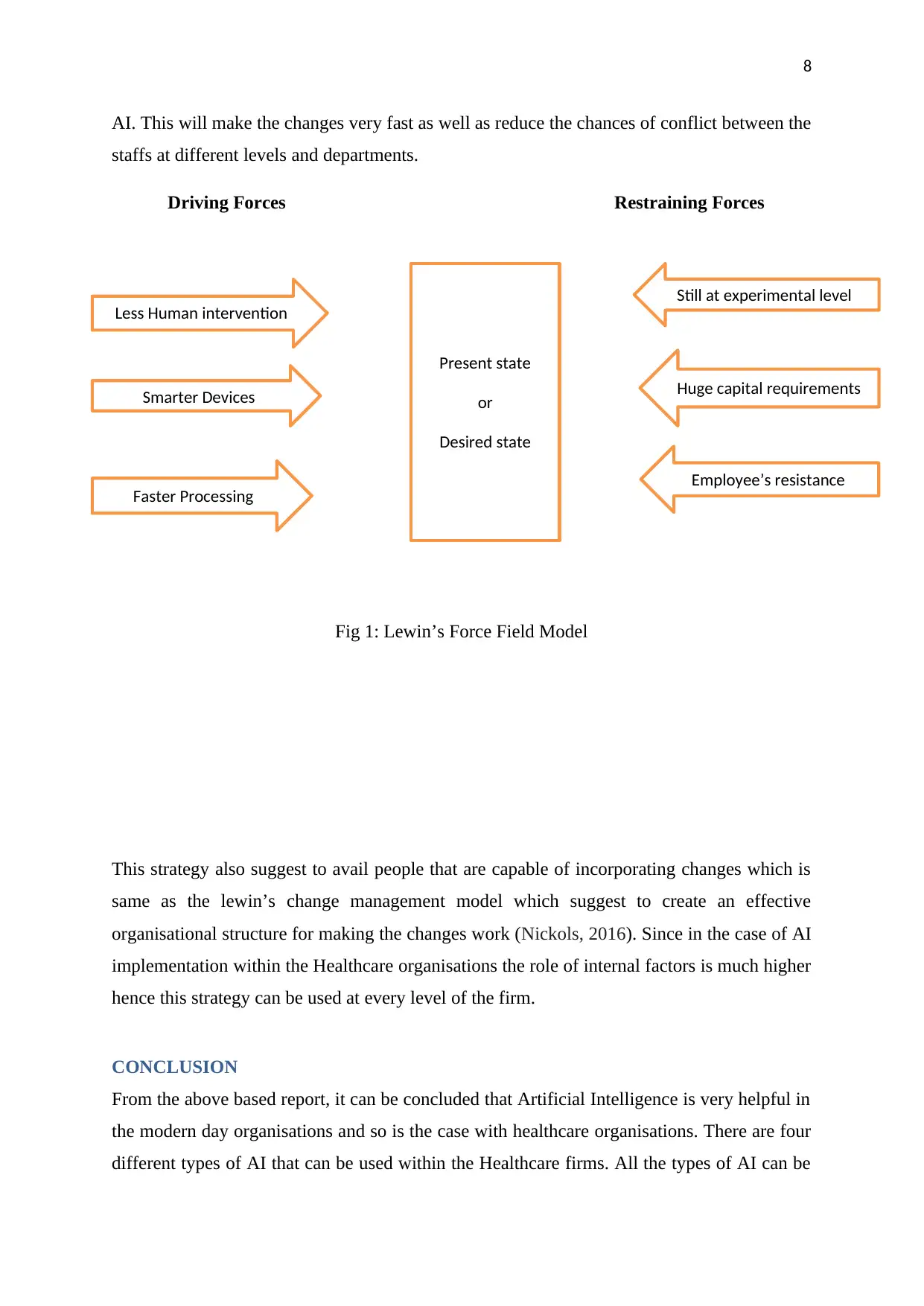
8
AI. This will make the changes very fast as well as reduce the chances of conflict between the
staffs at different levels and departments.
Driving Forces Restraining Forces
Fig 1: Lewin’s Force Field Model
This strategy also suggest to avail people that are capable of incorporating changes which is
same as the lewin’s change management model which suggest to create an effective
organisational structure for making the changes work (Nickols, 2016). Since in the case of AI
implementation within the Healthcare organisations the role of internal factors is much higher
hence this strategy can be used at every level of the firm.
CONCLUSION
From the above based report, it can be concluded that Artificial Intelligence is very helpful in
the modern day organisations and so is the case with healthcare organisations. There are four
different types of AI that can be used within the Healthcare firms. All the types of AI can be
Less Human intervention
Smarter Devices
Faster Processing
Present state
or
Desired state
Still at experimental level
Huge capital requirements
Employee’s resistance
AI. This will make the changes very fast as well as reduce the chances of conflict between the
staffs at different levels and departments.
Driving Forces Restraining Forces
Fig 1: Lewin’s Force Field Model
This strategy also suggest to avail people that are capable of incorporating changes which is
same as the lewin’s change management model which suggest to create an effective
organisational structure for making the changes work (Nickols, 2016). Since in the case of AI
implementation within the Healthcare organisations the role of internal factors is much higher
hence this strategy can be used at every level of the firm.
CONCLUSION
From the above based report, it can be concluded that Artificial Intelligence is very helpful in
the modern day organisations and so is the case with healthcare organisations. There are four
different types of AI that can be used within the Healthcare firms. All the types of AI can be
Less Human intervention
Smarter Devices
Faster Processing
Present state
or
Desired state
Still at experimental level
Huge capital requirements
Employee’s resistance
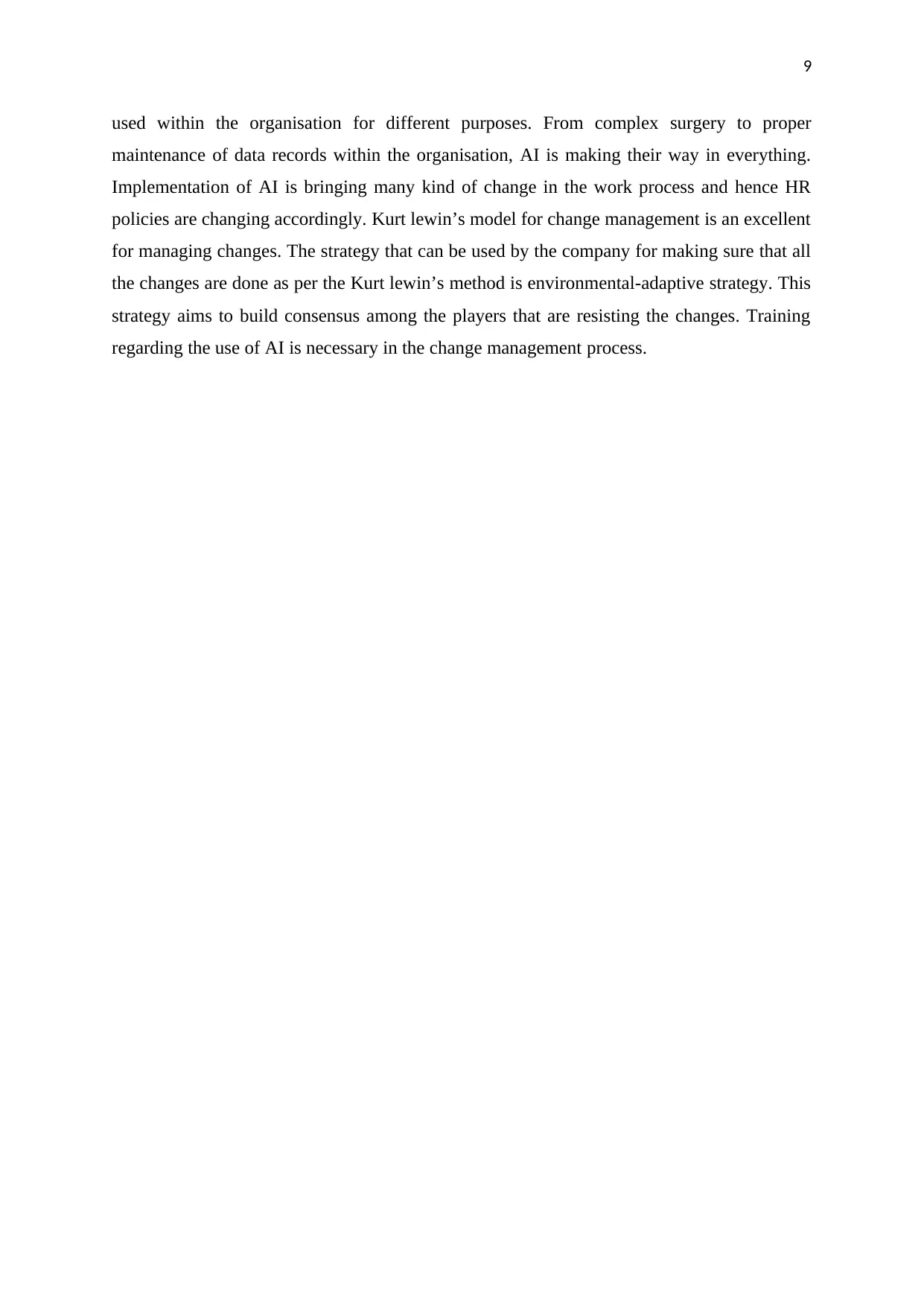
9
used within the organisation for different purposes. From complex surgery to proper
maintenance of data records within the organisation, AI is making their way in everything.
Implementation of AI is bringing many kind of change in the work process and hence HR
policies are changing accordingly. Kurt lewin’s model for change management is an excellent
for managing changes. The strategy that can be used by the company for making sure that all
the changes are done as per the Kurt lewin’s method is environmental-adaptive strategy. This
strategy aims to build consensus among the players that are resisting the changes. Training
regarding the use of AI is necessary in the change management process.
used within the organisation for different purposes. From complex surgery to proper
maintenance of data records within the organisation, AI is making their way in everything.
Implementation of AI is bringing many kind of change in the work process and hence HR
policies are changing accordingly. Kurt lewin’s model for change management is an excellent
for managing changes. The strategy that can be used by the company for making sure that all
the changes are done as per the Kurt lewin’s method is environmental-adaptive strategy. This
strategy aims to build consensus among the players that are resisting the changes. Training
regarding the use of AI is necessary in the change management process.
Secure Best Marks with AI Grader
Need help grading? Try our AI Grader for instant feedback on your assignments.
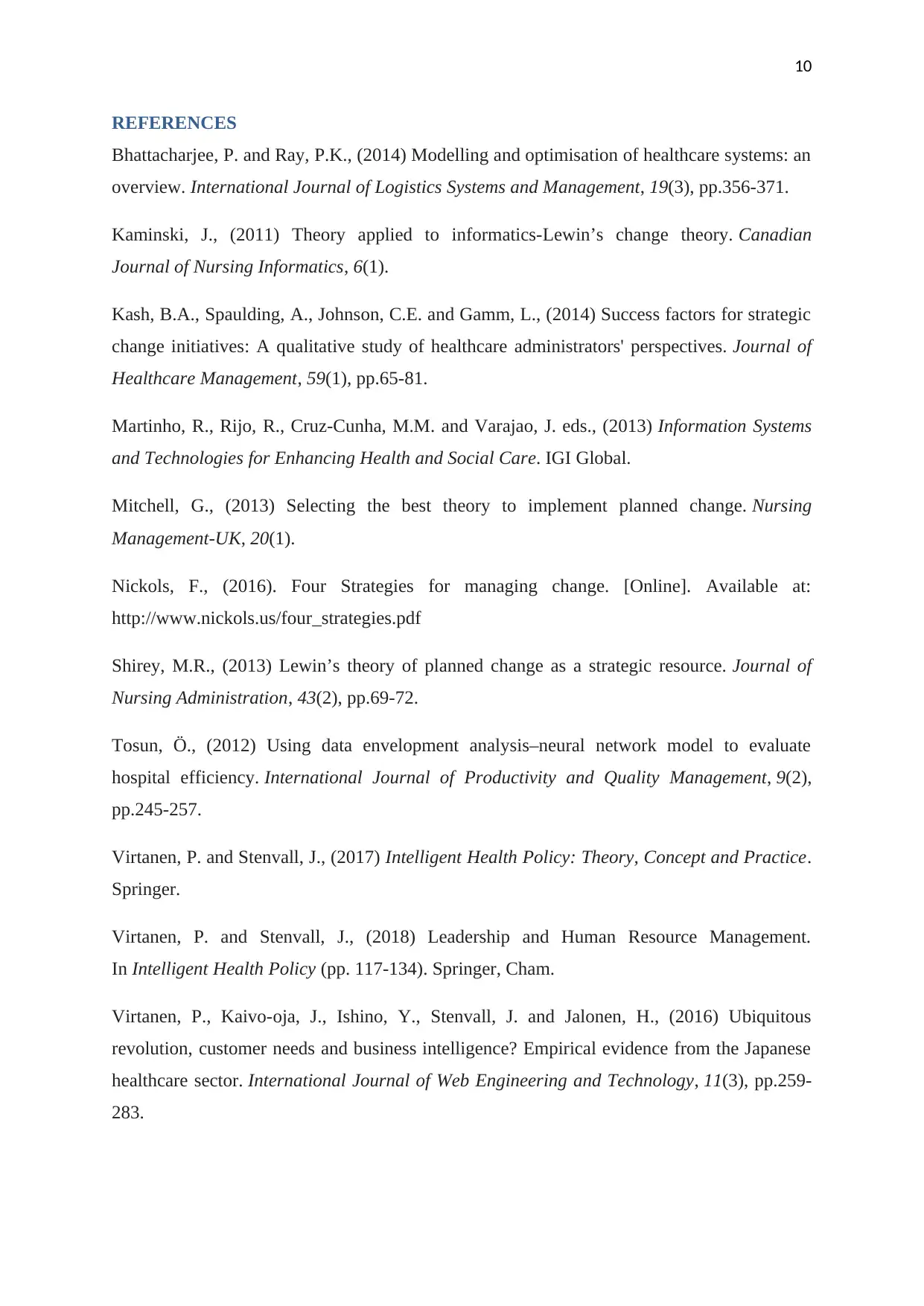
10
REFERENCES
Bhattacharjee, P. and Ray, P.K., (2014) Modelling and optimisation of healthcare systems: an
overview. International Journal of Logistics Systems and Management, 19(3), pp.356-371.
Kaminski, J., (2011) Theory applied to informatics-Lewin’s change theory. Canadian
Journal of Nursing Informatics, 6(1).
Kash, B.A., Spaulding, A., Johnson, C.E. and Gamm, L., (2014) Success factors for strategic
change initiatives: A qualitative study of healthcare administrators' perspectives. Journal of
Healthcare Management, 59(1), pp.65-81.
Martinho, R., Rijo, R., Cruz-Cunha, M.M. and Varajao, J. eds., (2013) Information Systems
and Technologies for Enhancing Health and Social Care. IGI Global.
Mitchell, G., (2013) Selecting the best theory to implement planned change. Nursing
Management-UK, 20(1).
Nickols, F., (2016). Four Strategies for managing change. [Online]. Available at:
http://www.nickols.us/four_strategies.pdf
Shirey, M.R., (2013) Lewin’s theory of planned change as a strategic resource. Journal of
Nursing Administration, 43(2), pp.69-72.
Tosun, Ö., (2012) Using data envelopment analysis–neural network model to evaluate
hospital efficiency. International Journal of Productivity and Quality Management, 9(2),
pp.245-257.
Virtanen, P. and Stenvall, J., (2017) Intelligent Health Policy: Theory, Concept and Practice.
Springer.
Virtanen, P. and Stenvall, J., (2018) Leadership and Human Resource Management.
In Intelligent Health Policy (pp. 117-134). Springer, Cham.
Virtanen, P., Kaivo-oja, J., Ishino, Y., Stenvall, J. and Jalonen, H., (2016) Ubiquitous
revolution, customer needs and business intelligence? Empirical evidence from the Japanese
healthcare sector. International Journal of Web Engineering and Technology, 11(3), pp.259-
283.
REFERENCES
Bhattacharjee, P. and Ray, P.K., (2014) Modelling and optimisation of healthcare systems: an
overview. International Journal of Logistics Systems and Management, 19(3), pp.356-371.
Kaminski, J., (2011) Theory applied to informatics-Lewin’s change theory. Canadian
Journal of Nursing Informatics, 6(1).
Kash, B.A., Spaulding, A., Johnson, C.E. and Gamm, L., (2014) Success factors for strategic
change initiatives: A qualitative study of healthcare administrators' perspectives. Journal of
Healthcare Management, 59(1), pp.65-81.
Martinho, R., Rijo, R., Cruz-Cunha, M.M. and Varajao, J. eds., (2013) Information Systems
and Technologies for Enhancing Health and Social Care. IGI Global.
Mitchell, G., (2013) Selecting the best theory to implement planned change. Nursing
Management-UK, 20(1).
Nickols, F., (2016). Four Strategies for managing change. [Online]. Available at:
http://www.nickols.us/four_strategies.pdf
Shirey, M.R., (2013) Lewin’s theory of planned change as a strategic resource. Journal of
Nursing Administration, 43(2), pp.69-72.
Tosun, Ö., (2012) Using data envelopment analysis–neural network model to evaluate
hospital efficiency. International Journal of Productivity and Quality Management, 9(2),
pp.245-257.
Virtanen, P. and Stenvall, J., (2017) Intelligent Health Policy: Theory, Concept and Practice.
Springer.
Virtanen, P. and Stenvall, J., (2018) Leadership and Human Resource Management.
In Intelligent Health Policy (pp. 117-134). Springer, Cham.
Virtanen, P., Kaivo-oja, J., Ishino, Y., Stenvall, J. and Jalonen, H., (2016) Ubiquitous
revolution, customer needs and business intelligence? Empirical evidence from the Japanese
healthcare sector. International Journal of Web Engineering and Technology, 11(3), pp.259-
283.
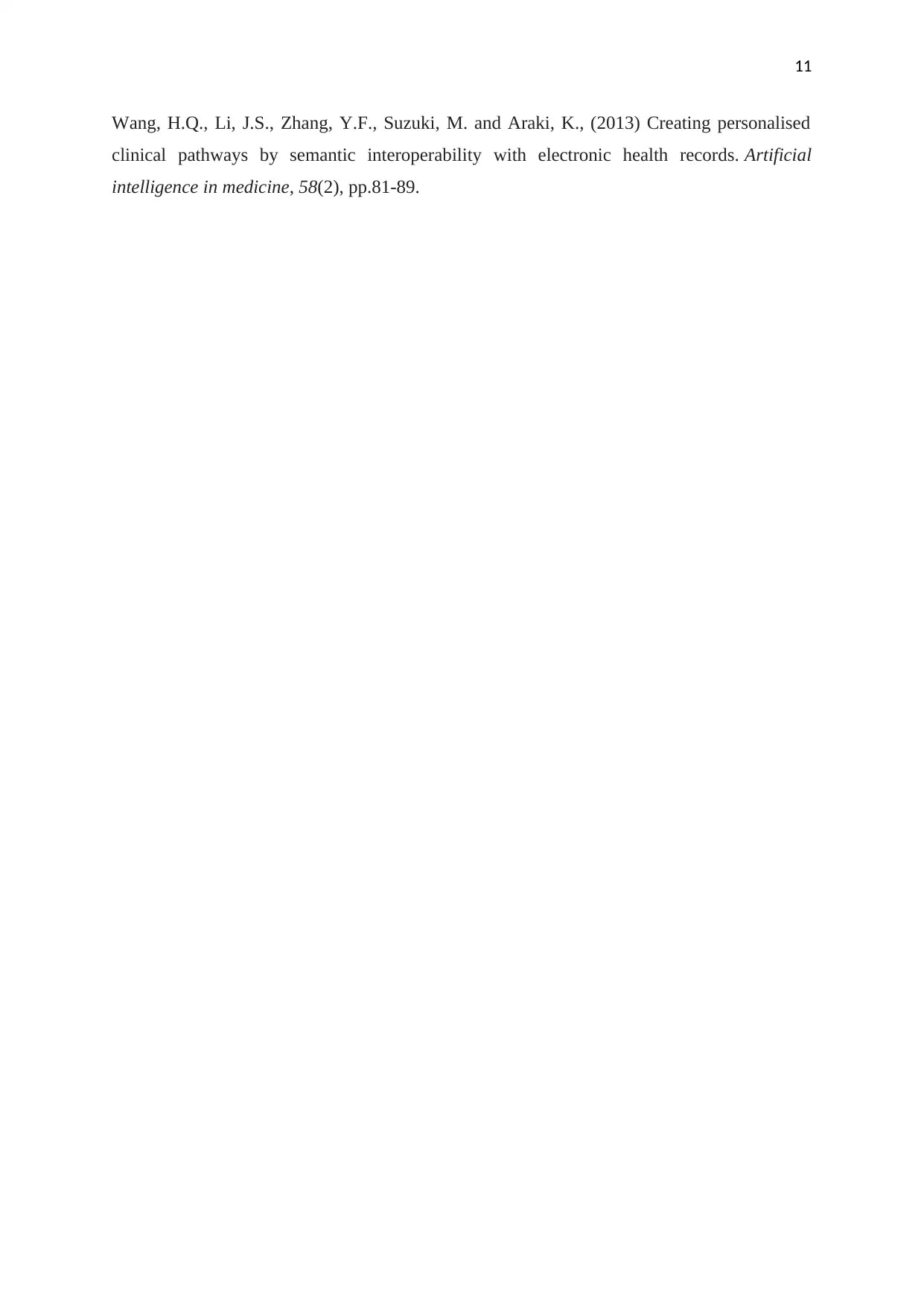
11
Wang, H.Q., Li, J.S., Zhang, Y.F., Suzuki, M. and Araki, K., (2013) Creating personalised
clinical pathways by semantic interoperability with electronic health records. Artificial
intelligence in medicine, 58(2), pp.81-89.
Wang, H.Q., Li, J.S., Zhang, Y.F., Suzuki, M. and Araki, K., (2013) Creating personalised
clinical pathways by semantic interoperability with electronic health records. Artificial
intelligence in medicine, 58(2), pp.81-89.

12
1 out of 13
Related Documents
Your All-in-One AI-Powered Toolkit for Academic Success.
+13062052269
info@desklib.com
Available 24*7 on WhatsApp / Email
![[object Object]](/_next/static/media/star-bottom.7253800d.svg)
Unlock your academic potential
© 2024 | Zucol Services PVT LTD | All rights reserved.




